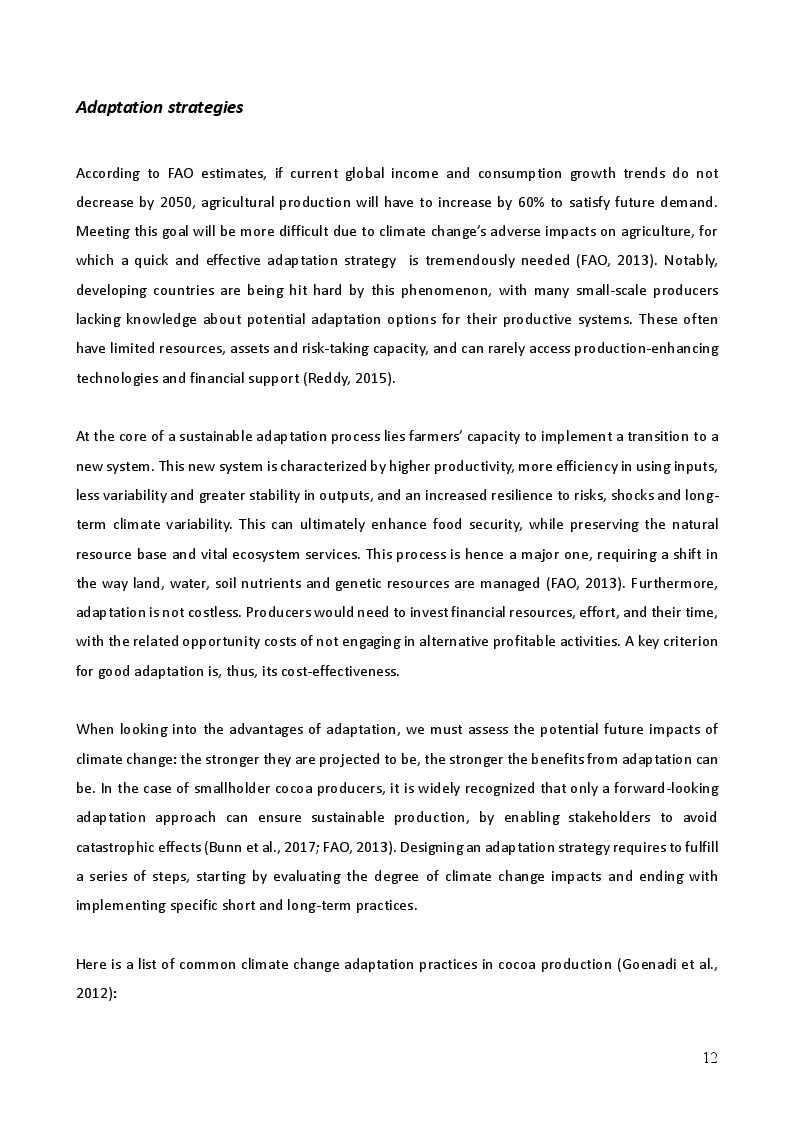Piloting a tool to assess climate change vulnerability among cocoa producers. The case of Jembrana, Bali, Indonesia
Measuring farmers’ vulnerability and capacity to adapt to climate change is a key challenge for the Rainforest Alliance, an organization working with small producers in several areas of the world. In November 2020, a pilot was conducted to test a tool designed specifically for this purpose. The tool was put to the test, for the first time, with 32 cocoa farmers in the district of Jembrana, Bali, Indonesia in collaboration with the local cooperative Kalimajari. The objective of the research, out of which this thesis has been produced, was to get relevant insights into the main issues faced by local farmers in climate change adaptation, collect their feedback on the tool’s capacity to capture their reality and propose adaptive measures. Furthermore, the research focused on women and young farmers, to understand more about their role in promoting adaptation. Globally, the results that emerged confirmed the tool’s effectiveness in assessing farmers’ vulnerability and promoting their resilience to climate change. A series of recommendations were produced out of this work, aimed at improving the tool’s usability and simplicity. These mainly concentrated on the use of wording, consistency, and relevance to the context. The final aim is to use these recommendations to further refine the tool and, thus, incorporate it into the organization’s Sustainable Agriculture Standard.
CONSULTA INTEGRALMENTE QUESTA TESI
La consultazione è esclusivamente in formato digitale .PDF
Acquista

CONSULTA INTEGRALMENTE QUESTA TESI
La consultazione è esclusivamente in formato digitale .PDF
Acquista
Informazioni tesi
| Autore: | Aurora Righetti |
| Tipo: | Laurea II ciclo (magistrale o specialistica) |
| Anno: | 2020-21 |
| Università: | Università degli Studi di Firenze |
| Facoltà: | Economia |
| Corso: | Scienze dell'economia |
| Relatore: | Leonardo Borsacchi |
| Lingua: | Inglese |
| Num. pagine: | 76 |
Forse potrebbe interessarti la tesi:
Sistemi di gestione sostenibile delle acque piovane in agricoltura nel territorio di Ruvo di Puglia
FAQ
Come consultare una tesi
Il pagamento può essere effettuato tramite carta di credito/carta prepagata, PayPal, bonifico bancario.
Confermato il pagamento si potrà consultare i file esclusivamente in formato .PDF accedendo alla propria Home Personale. Si potrà quindi procedere a salvare o stampare il file.
Maggiori informazioni
Perché consultare una tesi?
- perché affronta un singolo argomento in modo sintetico e specifico come altri testi non fanno;
- perché è un lavoro originale che si basa su una ricerca bibliografica accurata;
- perché, a differenza di altri materiali che puoi reperire online, una tesi di laurea è stata verificata da un docente universitario e dalla commissione in sede d'esame. La nostra redazione inoltre controlla prima della pubblicazione la completezza dei materiali e, dal 2009, anche l'originalità della tesi attraverso il software antiplagio Compilatio.net.
Clausole di consultazione
- L'utilizzo della consultazione integrale della tesi da parte dell'Utente che ne acquista il diritto è da considerarsi esclusivamente privato.
- Nel caso in cui l’utente che consulta la tesi volesse citarne alcune parti, dovrà inserire correttamente la fonte, come si cita un qualsiasi altro testo di riferimento bibliografico.
- L'Utente è l'unico ed esclusivo responsabile del materiale di cui acquista il diritto alla consultazione. Si impegna a non divulgare a mezzo stampa, editoria in genere, televisione, radio, Internet e/o qualsiasi altro mezzo divulgativo esistente o che venisse inventato, il contenuto della tesi che consulta o stralci della medesima. Verrà perseguito legalmente nel caso di riproduzione totale e/o parziale su qualsiasi mezzo e/o su qualsiasi supporto, nel caso di divulgazione nonché nel caso di ricavo economico derivante dallo sfruttamento del diritto acquisito.
Vuoi tradurre questa tesi?
Per raggiungerlo, è fondamentale superare la barriera rappresentata dalla lingua. Ecco perché cerchiamo persone disponibili ad effettuare la traduzione delle tesi pubblicate nel nostro sito.
Per tradurre questa tesi clicca qui »
Scopri come funziona »
DUBBI? Contattaci
Contatta la redazione a
[email protected]
Parole chiave
Tesi correlate
Non hai trovato quello che cercavi?
Abbiamo più di 45.000 Tesi di Laurea: cerca nel nostro database
Oppure consulta la sezione dedicata ad appunti universitari selezionati e pubblicati dalla nostra redazione
Ottimizza la tua ricerca:
- individua con precisione le parole chiave specifiche della tua ricerca
- elimina i termini non significativi (aggettivi, articoli, avverbi...)
- se non hai risultati amplia la ricerca con termini via via più generici (ad esempio da "anziano oncologico" a "paziente oncologico")
- utilizza la ricerca avanzata
- utilizza gli operatori booleani (and, or, "")
Idee per la tesi?
Scopri le migliori tesi scelte da noi sugli argomenti recenti
Come si scrive una tesi di laurea?
A quale cattedra chiedere la tesi? Quale sarà il docente più disponibile? Quale l'argomento più interessante per me? ...e quale quello più interessante per il mondo del lavoro?
Scarica gratuitamente la nostra guida "Come si scrive una tesi di laurea" e iscriviti alla newsletter per ricevere consigli e materiale utile.
La tesi l'ho già scritta,
ora cosa ne faccio?
La tua tesi ti ha aiutato ad ottenere quel sudato titolo di studio, ma può darti molto di più: ti differenzia dai tuoi colleghi universitari, mostra i tuoi interessi ed è un lavoro di ricerca unico, che può essere utile anche ad altri.
Il nostro consiglio è di non sprecare tutto questo lavoro:
È ora di pubblicare la tesi

